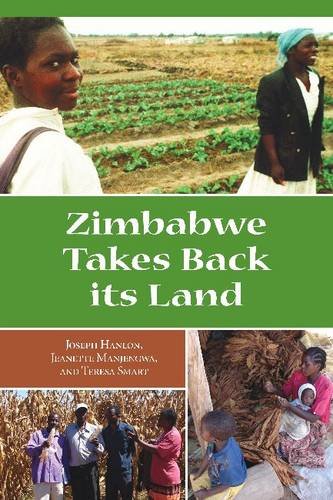Has Zimbabwe’s land reform actually been a success? A new book says yes.
Buy this book "Zimbabwe Takes Back Its Land by Joseph Hanlon,
Jeannette Manjengwa, Teresa Smart" here at Amazon.comI’ve never been to Zimbabwe, so tend to get my messages from the news coverage. On land issues, that means a picture of a predatory Zimbabwe cover state driving white farmers off the land and handing it out to cronies and bogus war veterans, who fail to produce anything much in the way of crops.
Zimbabwe Takes Back its Land, a new book co-authored by Joe Hanlon, Jeanette Mangengwa and Teresa Smart, sheds a very different light. Based on field visits, numerous conversations with farmers, and mining the available data, it paints a much more nuanced picture that is broadly positive about the impact of Zimbabwe’s land reform. It makes some telling points, including:
The media story about efficient white commercial farms is a half truth at best: at independence in 1980, 700,000 black farmers were squeezed onto 53% of the farmland, while 6,000 white farmers had 46% (and often the best land at that). Yet when Zimbabwe achieved majority rule, one third of white farmers were insolvent and a third were just about breaking even. Only 5% (300 people!) could be described as ‘very profitable’.
It often takes a generation for a land reform to produce results – the larger of Zimbabwe’s two post apartheid land reforms is only a decade old, but new farmers have already caught up with the previous white-dominated system in production (although of course, there are always better and worse farmers in any category). That is initially being achieved by bringing some of the idle land into production, but yields are also rising.
Zimbabwe is special in several ways: one of the best educated populations in Africa actually sees farming as a good way to earn a living. Those making a success of farming include ex army generals, teachers and businesspeople.
The book is not an apologia for Robert Mugabe’s government – it acknowledges corruption and cronyism, but argues that the more recent land reform was driven from below, initially in the face of Zanu opposition, before the government finally decided to accept a fait accomplit – ‘perhaps the only thing Robert Mugabe and the British Government agree on is a myth, namely that Mugabe was responsible for the land occupations’. The book also points out that not all cronies are the same – some are just interested in speculating on land values, but others have actually become successful commercial farmers.
The more recent land reform comes in two types: ‘A1’ farms handed out about 150,000 plots of 6 hectares to smallholders by dividing up large white farms, while the ‘A2’ model sought to create large black commercial farms by handing over much larger areas of land to about 23,000 farmers.
One side effect of Zimbabwe’s educational record is plentiful research and survey data, which the authors make the most of in exploring the impact of the land reform. Has most land gone to government cronies? No. Large-scale black commercial farmers have received just 7% of the land handed out since independence.
The first half of the book covers this history, the second surveys today’s agriculture, with evocative reportage from the field supplementing the number crunching. The book draws lessons about which farmers succeed and which fail, and why.
Overall, a lot of the smaller A1 farmers (including a significant number of women beneficiaries of the land reform) have become successful small commercial producers, breaking into markets for tobacco, maize and barley, often as contract farmers. This despite the lack of support for new farmers (a contrast to the lavish support for white newbies in earlier times).
The big A2 farmers have faced more of a struggle, both because hyperinflation and economic crisis had more of an impact , and because political infighting and favouritism tends to target the big farms. The largely unreported story here, though, is that the dollarization of 2009 and subsequent economic stabilisation has led to a resurgence of agriculture.
Not all is great of course, land reform has led to deforestation, and gold panning is causing environmental damage. Paid agricultural Zimbabwe land hungerworkers now number more than a million, and often face low wages and poor working conditions. Water and irrigation remain a big challenge.
The book concludes:
‘In the biggest land reform in Africa, 6,000 white farmers have been replaced by 245,000 Zimbabwean farmers. Zimbabwe’s land reform has not been neat, and huge problems remain. But 245,000 new farmers have received land, and most of them are farming it. They have raised their own standard of living; have already reached production levels of the former white farmers; and with a bit of support, are ready to substantially increase that production.’
So who’s right, the book or the Daily Mail? I’m off to Zimbabwe for a few days in March, so hopefully will get a clearer idea then, but would love to hear your views before I head off.
http://www.oxfamblogs.org/fp2p/?p=13405Zimbabwe Takes Back its Land
